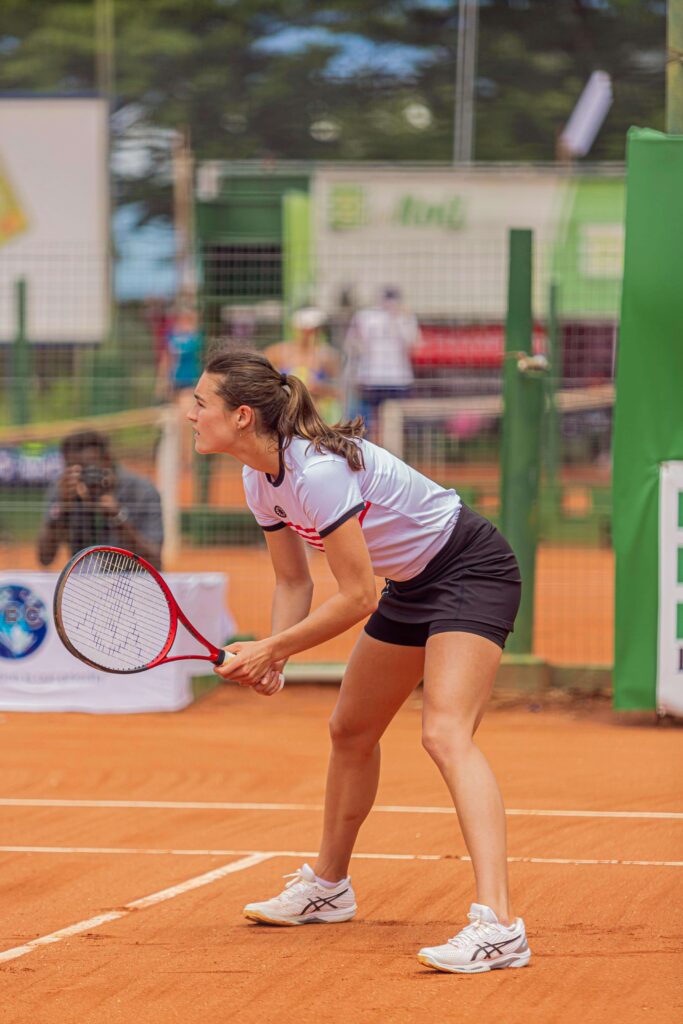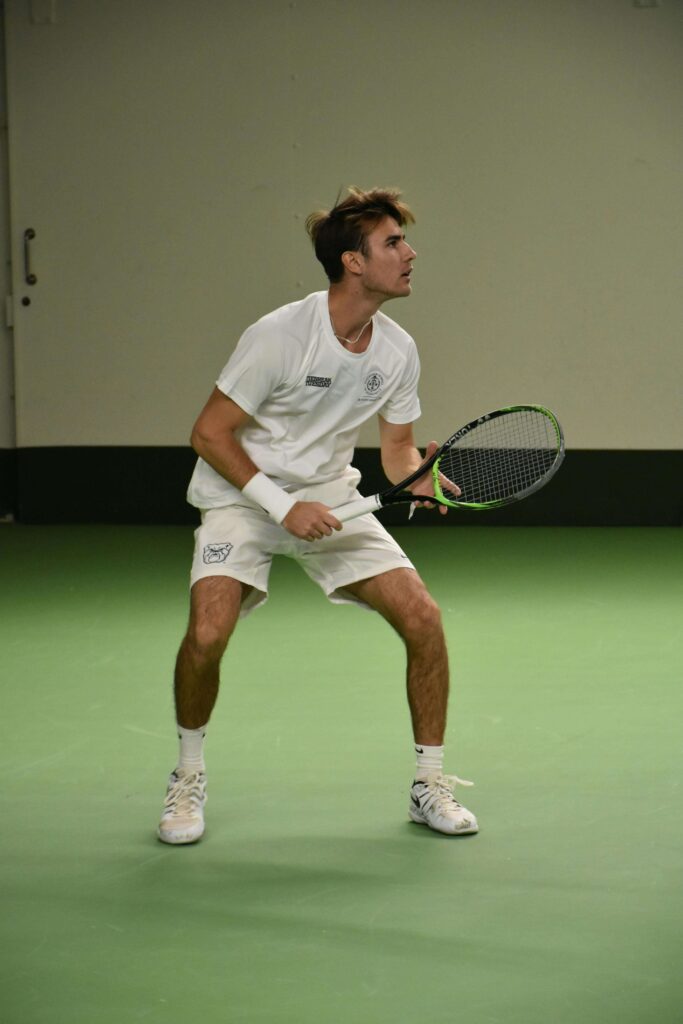Drills and Tips for Agility, Balance, and Court Positioning
Let’s Talk About Footwork (Yes, Really!)
Ever watched Roger Federer glide across the court and thought, “How does he make it look so easy?” Well, I’ve got news for you – it’s not magic, it’s footwork. And while none of us may move quite like Roger, we can definitely get better at it.
I’ve spent years coaching players of all levels, and here’s what I’ve learned: good footwork isn’t just about being quick. It’s about being smooth, efficient, and (most importantly) being in the right place at the right time. Let’s break down how you can improve your movement on the court without turning it into rocket science.
Why Your Footwork Matters More Than You Think
Think of footwork as your tennis foundation. You wouldn’t build a house on shaky ground, right? The same goes for your tennis game. Here’s what good footwork actually does for you:
- Helps you reach those “impossible” shots (you know, the ones you usually watch fly by)
- Keeps you from feeling completely exhausted after just a few games
- Makes your shots more consistent (because you’re actually in a position to hit them properly)
- Helps prevent those annoying injuries that come from awkward movements
Here’s why footwork is crucial:
- Agility: Fast, precise footwork allows you to respond quickly to your opponent’s shots.
- Balance: Proper foot placement ensures you stay stable during rapid, aggressive movements.
- Court Positioning: Being able to position yourself correctly means you’re always ready for the next shot.
Master The Basic Moves Everyone Should Know
- The Split Step: Your Tennis Starting Block stepbystep guide to add distance
Remember jumping rope as a kid? The split step is kind of like that but with a purpose. It’s that little hop you do right before your opponent hits the ball.
Here’s how to make it work: to use a drill
- Time your little hop for when your opponent’s about to hit
- Land soft and ready (think cat, not elephant)
- Keep your feet about shoulder-width apart
- Bend those knees slightly (but don’t squat!)
Try This: Next time you’re warming up, focus only on your split step for the first few minutes. Don’t worry about where the ball goes – just get that timing down.
2. The Side Shuffle: Your Court Coverage Friend
This is your bread-and-butter movement for covering the court. No crossing feet, no fancy moves – just efficient lateral movement.
Make it work for you:
- Stay low (but comfortable)
- Keep your feet parallel to the baseline
- Move like you’re trying to sneak up on someone
- Keep your upper body steady
Quick Drill: Put two water bottles about 10 feet apart and practice shuffling between them. Do this for 30 seconds, rest, repeat. Simple but effective!
3. Crossover Steps: For When You Need to Book It
perfect tempo with this easy
Sometimes, you just need to cover a lot of ground fast. That’s where the crossover step comes in handy.
The basics:
- Start with a split-step
- Cross one foot over the other (like you’re speed skating)
- Keep your eyes level (the court’s spinning enough already!)
- Get back to ready position ASAP
Real Talk: Common Footwork Problems (And How to Fix Them)
I Always Feel Like I’m Late to the Ball
Sound familiar? You’re probably waiting too long to move. Try this: start moving as soon as the ball leaves your opponent’s racket. Don’t wait to see where it’s going – by then, it’s too late!
“I Get Tired Really Quickly”
If you’re feeling gassed after a few games, you might be:
- Taking too many steps (smaller, quicker steps are usually better)
- Standing up too straight (stay in a slight athletic stance)
- Holding your breath (yes, people actually do this!)
“I Feel Clumsy on Court”
No worries – we’ve all been there. Try this simple progression:
- Practice footwork patterns without a ball
- Add shadow swings
- Have someone feed you balls slowly
- Gradually increase the pace
Making It Work in Real Matches
Here’s the thing about footwork – it’s not just about doing drills. You need to make it work when it counts. Try these tips:
- Start Every Point Right
- Get in a good, ready position
- Do your split-step
- Stay light on your feet
- Between Points
- Reset your position
- Take a breath
- Get ready to move again
- When You’re Tired
- Focus on smaller steps
- Keep your routine simple
- Remember: good footwork actually saves energy
Your 15-Minute Daily Footwork Routine
Yes, just 15 minutes! Here’s a simple routine you can do before you play:
- Shadow Movement (5 minutes)
- Practice split steps
- Side shuffles
- Crossover steps
- Pattern Work (5 minutes)
- Move corner to corner
- Practice approach steps
- Work on recovery movements
- Speed Ladders or Lines (5 minutes)
- Quick feet drills
- Forward/backward movement
- Side-to-side agility
The Right Gear Matters (But Don’t Overthink It)
You don’t need fancy equipment, but you do need:
- Tennis shoes that fit well (no running shoes!)
- Comfortable clothes that let you move
- A court surface that’s not slippery
Keep It Simple and Have Fun
Remember, the goal isn’t to become a footwork robot. It’s to move better so you can enjoy your tennis more. Start with these basics, practice them regularly, and you’ll be surprised at how much better you’ll move on the court. Hitting out of thick rough.
And hey, if you mess up sometimes (we all do), remember: even Nadal trips occasionally. It’s part of the game!
- Check out our footwork video series [link]
- Join our weekly tennis tips newsletter [link]
- Follow us on social media for daily drills [link]
Match-Specific Footwork Scenarios
Serving and Return Games
When you’re serving, your footwork might seem less important, but it’s crucial for what comes next. Here’s how to set yourself up:
- Pre-Serve Position
- Find your comfortable stance
- Keep your weight balanced
- Be ready to move after your serve
- After the Serve
- Push off your back foot
- Move toward the center mark
- Get ready for the return
For return games, your footwork can make or break the point:
- Start in a dynamic, ready position
- Make small adjustment steps as your opponent tosses the ball
- Split step right as they contact the serve
Baseline Rally Footwork
Ever notice how the pros seem to be everywhere at once during baseline rallies? Here’s their secret:
- Recovery Steps
- Push off your outside foot after each shot
- Take a diagonal path back to the center
- Use crossover steps for longer distances
- Direction Changes
- Keep your steps short and quick
- Stay low through the change
- Use your non-dominant hand for balance
NetPlay and Approach Shots
Moving forward isn’t just about running to the net. Here’s how to do it right:
- The Approach
- Take shorter, quicker steps as you move forward
- Stay balanced through your shot
- Prepare for your split step at the net
- Net Movement
- Small adjustment steps between volleys
- Stay on the balls of your feet
- Keep your racquet up and ready
Pro Tips from the Tour
Rafael Nadal’s Movement Secrets
- Always returns to a ready position between shots
- Takes small adjustment steps constantly
- Uses explosive first steps in every direction
Novak Djokovic’s Sliding Technique
- Starts the slide early
- Keeps his center of gravity low
- Uses his non-dominant hand for balance
- Recovers quickly to the ready position
Roger Federer’s Efficiency Tips
- Minimal unnecessary movement
- Perfect split-step timing
- Smooth direction to change
- Economic recovery paths
Advanced Footwork Drills
The Spider Web Drill
Setup: Place six cones in a web pattern on your side of the court. Execution:
- Start at the center
- Sprint to each cone in sequence
- Return to the center between each sprint
- Maintain proper form throughout. Benefits: Improves multi-directional movement and recovery
The Figure-8 Drill
Setup: Place two cones 12 feet apart. Execution:
- Run figure-8 patterns around the cones
- Stay low throughout
- Use proper footwork patterns
- Change directions every 30 second.s Benefits: Enhances agility and direction changes
The Random Ball Drill; Tips for Drills
Setup: Partner with a basket of balls. Execution:
- Partner feeds balls to random court positions
- Use proper footwork to reach each ball
- Focus on recovery between shots
- Maintain split step timing Benefits: Simulates match conditions and improves reaction time
Footwork for Different Court Surfaces
Hard Court Movement
- Quick, explosive movements
- Emphasis on cushioning
- Short, controlled steps
- Immediate direction changes
Clay Court Adjustments
- Controlled sliding
- Longer recovery paths
- Modified split-step timing
- Emphasis on balance through slides
Grass Court Technique
- Shorter steps
- Lower center of gravity
- Quick direction changes
- Careful plant and push movements
Mental Aspects of Footwork
Focus Points
- Stay present between points
- Maintain rhythm in movement
- Trust your training
- Keep breathing steady
Pre-Point Routine
- Reset your stance
- Check your distance from the baseline
- Take a deep breath
- Prepare for the split step
Common Match Situations
Playing Against a Big Server
- Start slightly further back
- Take smaller split steps
- Be ready to move in any direction
- Stay light on your feet
Handling Drop Shots
- Recognize the shot early
- Use crossover steps to move forward
- Control your speed as you approach
- Prepare for a possible lob
Dealing with Aggressive Baseline Players
- Start slightly inside the baseline
- Take small adjustment steps between shots
- Stay low for quick direction changes
- Maintain good recovery positions
Recovery and Maintenance
Post-Match Routine
- Light jogging to cool down
- Dynamic stretching
- Foot and ankle exercises
- Recovery nutrition
Injury Prevention
- Regular flexibility work
- Proper warm-up routine
- Adequate rest between sessions
- Proper shoe selection and replacement
Measuring Your Progress
Weekly Goals
- Track movement patterns
- Film your footwork
- Note energy levels
- Record match statistics
Monthly Assessments
- Compare video footage
- Test agility drills
- Update training plans
- Adjust goals as needed
Final Thoughts
Remember, great footwork isn’t built overnight. It’s the result of consistent practice, attention to detail, and patience. Start with the basics, gradually add complexity, and, most importantly, stay committed to your improvement journey.
Don’t be discouraged if you find some days harder than others – that’s completely normal. Focus on progress, not perfection, and you’ll be amazed at how your movement improves over time.









